
Rick Dangerous is a platform game developed by Core Design for the Acorn Archimedes, Amiga, Atari ST, Amstrad CPC, ZX Spectrum, Commodore 64, and MS-DOS. The game was released in 1989 and published by MicroProse on the Firebird Software label in the UK, and on the MicroPlay label in America. It was also published in Spain by Erbe Software. Later, it was released with two other games, Stunt Car Racer and MicroProse Soccer, on the Commodore 64 Powerplay 64 cartridge. The game was followed by a sequel, Rick Dangerous 2, in 1990. Loosely based on the Indiana Jones film franchise, the game received mixed reviews from critics.

Game Over is an action video game developed by Dinamic Software and published by Imagine Software in 1987. It was released for the Amstrad CPC, Commodore 64, MSX, Thomson TO7, and ZX Spectrum. The game includes some adventure game elements. A prompted unrated sequel, Game Over II, was released in 1987.

Laser Squad is a turn-based tactics video game, originally released for the ZX Spectrum and later for the Commodore 64, Amstrad CPC, MSX, Amiga, Sharp MZ-800 and Atari ST and PC computers between 1988 and 1992. It was designed by Julian Gollop and his team at Target Games and published by Blade Software, expanding on the ideas applied in their earlier Rebelstar series. Laser Squad originally came with five mission scenarios, with an expansion pack released for the 8-bit versions, containing a further two scenarios.

Jet Set Willy II: The Final Frontier is a platform game released 1985 by Software Projects as the Amstrad CPC port of Jet Set Willy. It was then rebranded as the sequel and ported to other home computers. Jet Set Willy II was developed by Derrick P. Rowson and Steve Wetherill rather than Jet Set Willy programmer Matthew Smith and is an expansion of the original game, rather than an entirely new one.

Tornado Low Level is a multidirectional flight game developed by Costa Panayi and published in 1984 by the company he co-founded, Vortex Software. The game was first released for the ZX Spectrum, and later ported to the Amstrad CPC and Commodore 64.
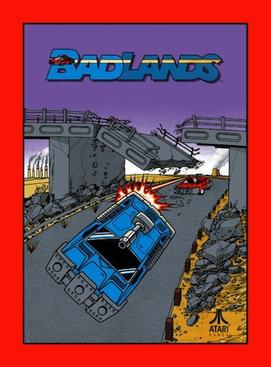
Badlands is a 1989 arcade video game published by Atari Games. It was ported by Domark under the Tengen label to the Amiga, Amstrad CPC, Atari ST, Commodore 64, and ZX Spectrum. The game is a re-themed version of Atari's previous racing games Super Sprint and Championship Sprint with the addition of vehicular combat. Badlands is set in the aftermath of a nuclear war and races around abandoned wastelands with many hazards. Three gun-equipped cars race around a track to win prizes.
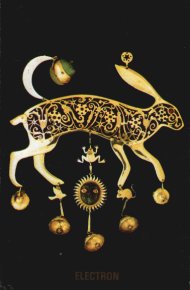
Hareraiser was a video game released in 1984 in the UK in two parts: Prelude and Finale. The game was published for Acorn Electron, Amstrad CPC, BBC Micro Model B, Commodore 64, VIC-20, Dragon 32, MSX, Oric Atmos, and ZX Spectrum at £8.95 for each part.
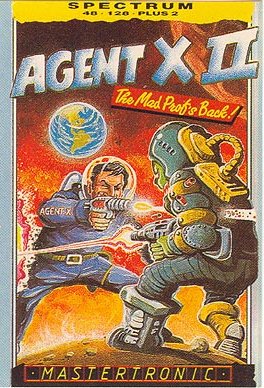
Agent X II: The Mad Prof's Back is a computer game released in 1987 for the ZX Spectrum, Amstrad CPC and Commodore 64. It is the follow-up to the ZX Spectrum game Agent X.

WWF WrestleMania is a game developed by Twilight and published by Ocean Software in 1991 for the Amiga, Amstrad CPC, Atari ST, Commodore 64, ZX Spectrum, and DOS. Named after the World Wrestling Federation's (WWF) annual pay-per-view event WrestleMania, it was the first WWF licensed game available for these computers which were still dominant in Europe. It was followed on most of these computers by 1992's WWF European Rampage Tour.
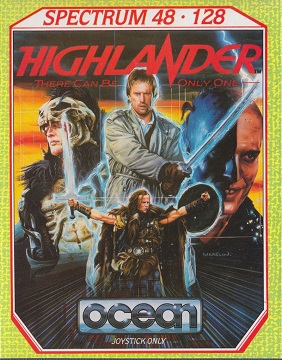
Highlander is a video game tie-in to the Highlander franchise released in 1986, the same year as the film, published by Ocean Software for the ZX Spectrum, Commodore 64 and Amstrad CPC home computers. Highlander was panned by reviewers.
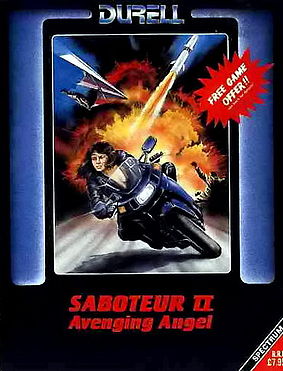
Saboteur II: Avenging Angel, also known as Saboteur 2, is an action-adventure game created by Clive Townsend and released by Durell Software in 1987 for the ZX Spectrum, Amstrad CPC, Commodore 64, and MS-DOS compatible operating systems. A sequel to 1985's Saboteur, the player controls a sister of Ninja from the first game on a mission to avenge his death. Saboteur II was one of the first action-adventure games with a female protagonist and was well received by critics.
Football Manager is a video game series published and developed by Addictive Games, the label set up by the game's creator Kevin Toms. The first game was released in 1982. It was then ported to most home computers during the 1980s and spawned several sequels: Football Manager 2 (1988) and Football Manager World Cup Edition (1990), both designed by Kevin Toms, and finally Football Manager 3 (1992), without Toms' involvement. Football Manager 3 sold poorly, and as a result the series came to an end. The series was claimed to have sold over a million copies by 1992 and close to two million copies overall. The game was to start a whole new genre of computer game, the football management simulation.

Fun School is a series of educational packages developed and published in the United Kingdom by Europress Software, initially as Database Educational Software. The original Fun School titles were sold mostly by mail order via off-the-page adverts in the magazines owned by Database Publications. A decision was made to create a new set of programs, call the range Fun School 2, and package them more professionally so they could be sold in computer stores around the UK. Every game comes as a set of three versions, each version set to cater for a specific age range.

Alien Highway: Encounter 2 is an isometric action game released by Vortex in 1986 for the ZX Spectrum and Amstrad CPC. It was programmed by Mark Haigh-Hutchinson and is the sequel to Highway Encounter.

Brian Clough's Football Fortunes is a sports video game featuring English football player Brian Clough. It was released in 1987 for the Amiga, Amstrad CPC, Amstrad PCW, Atari 8-bit computers, Atari ST, BBC Micro, Commodore 16, Plus/4, Commodore 64, MS-DOS, Acorn Electron, MSX, and ZX Spectrum.
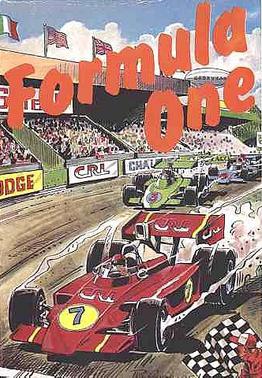
Formula One is a Formula One racing management video game published in 1985 by CRL Group PLC. It was developed by G.B. Munday and B.P. Wheelhouse for the ZX Spectrum, and converted to Amstrad CPC by Richard Taylor.

Turbo the Tortoise is a platform game published in 1992 by Hi-Tec Software, developed by Visual Impact for the ZX Spectrum, Amstrad CPC and Commodore 64.

Human Killing Machine is a 2D fighting video game. The game was developed by British company Tiertex, who hired external team Blue Turtle to produce the graphics, and published by U.S. Gold, released in March 1989. It was touted as a sequel to Tiertex's home computer conversion of Street Fighter. It was released for 8-bit and 16-bit home computer formats.

Ghostbusters II is a 1989 action game based on the film of the same name. It was published by Activision for various computer platforms. British studio Foursfield developed a version for Commodore 64, Amiga, Atari ST, Amstrad CPC and ZX Spectrum, which also got ported to the MSX by New Frontier. It features three levels based on scenes from the film. Dynamix developed a separate version for the DOS, also based on the film. The non-DOS versions were praised for the graphics and audio, but criticized for long loading times, disk swapping, and the final level. The DOS, Commodore 64 and Amiga versions were the only versions released in North America.
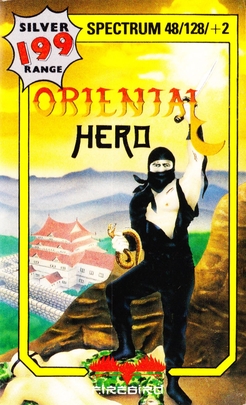
Oriental Hero is a ninja-themed side-scrolling beat-'em-up video game published in 1987 exclusively for the ZX Spectrum under the Firebird Software Silver Range label. It was developed by Tron Software as the sequel to their 1986 multi-platform release, Ninja Master.



















